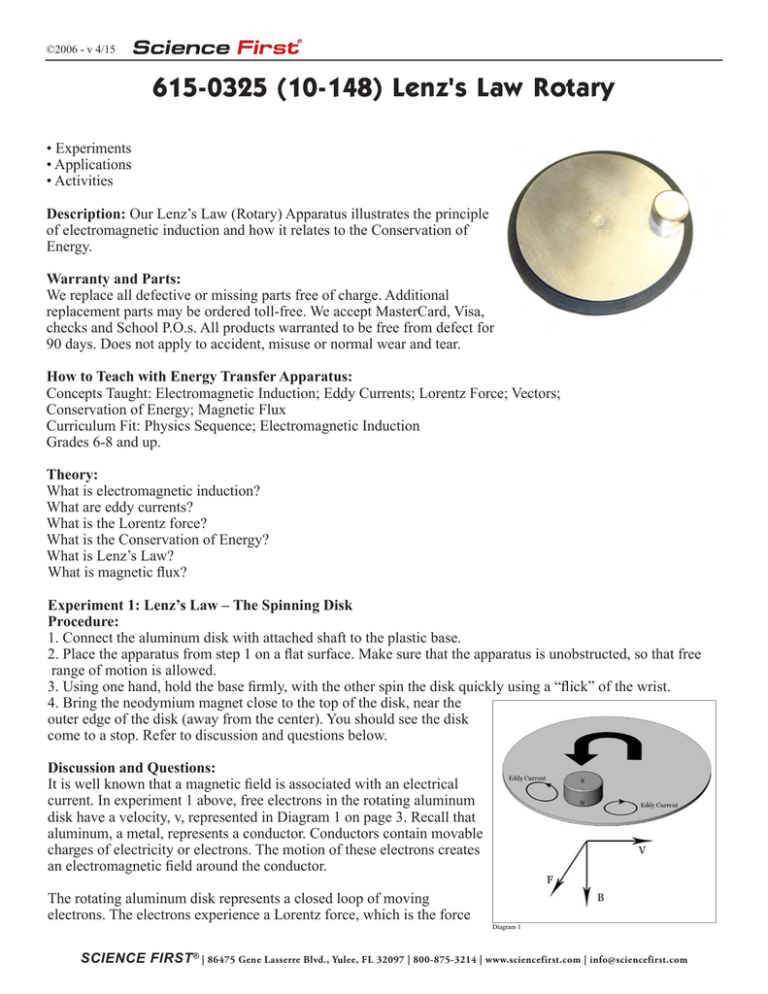
©2006 - v 4/15
615-0325 (10-148) Lenz's Law Rotary
• Experiments
• Applications
• Activities
Description: Our Lenz’s Law (Rotary) Apparatus illustrates the principle
of electromagnetic induction and how it relates to the Conservation of
Energy.
Warranty and Parts:
We replace all defective or missing parts free of charge. Additional
replacement parts may be ordered toll-free. We accept MasterCard, Visa,
checks and School P.O.s. All products warranted to be free from defect for
90 days. Does not apply to accident, misuse or normal wear and tear.
How to Teach with Energy Transfer Apparatus:
Concepts Taught: Electromagnetic Induction; Eddy Currents; Lorentz Force; Vectors;
Conservation of Energy; Magnetic Flux
Curriculum Fit: Physics Sequence; Electromagnetic Induction
Grades 6-8 and up.
Theory:
What is electromagnetic induction?
What are eddy currents?
What is the Lorentz force?
What is the Conservation of Energy?
What is Lenz’s Law?
What is magnetic flux?
Experiment 1: Lenz’s Law – The Spinning Disk
Procedure:
1. Connect the aluminum disk with attached shaft to the plastic base.
2. Place the apparatus from step 1 on a flat surface. Make sure that the apparatus is unobstructed, so that free
range of motion is allowed.
3. Using one hand, hold the base firmly, with the other spin the disk quickly using a “flick” of the wrist.
4. Bring the neodymium magnet close to the top of the disk, near the
outer edge of the disk (away from the center). You should see the disk
come to a stop. Refer to discussion and questions below.
Discussion and Questions:
It is well known that a magnetic field is associated with an electrical
current. In experiment 1 above, free electrons in the rotating aluminum
disk have a velocity, v, represented in Diagram 1 on page 3. Recall that
aluminum, a metal, represents a conductor. Conductors contain movable
charges of electricity or electrons. The motion of these electrons creates
an electromagnetic field around the conductor.
The rotating aluminum disk represents a closed loop of moving
electrons. The electrons experience a Lorentz force, which is the force
SCIENCE FIRST ® | 86475 Gene Lasserre Blvd., Yulee, FL 32097 | 800-875-3214 | www.sciencefirst.com | info@sciencefirst.com
©2006 - v 4/15
exerted on a charged particle in an electromagnetic field. The electrons experience a force due to the electric
field and the magnetic field. In Diagram 1, the Lorentz force, F, is radial and it points away from the center of
the disk. Lorentz’s Law is mathematically defined below.
F = qvB
q = charge of the particle (coulombs)
v = velocity of the particle (m/sec)
B = magnetic field (tesla)
The induced electric currents in the disk are referred to as eddy currents. Eddy currents occur when a moving
magnetic field intersects a conductor. The current in the disk creates the electromagnet which has a magnetic
field that opposes the change in the external magnetic field brought forth by bringing the neodymium magnet
near the periphery of the disk. In essence, these eddy currents are used to help “brake” the disk to a stop. Thus,
we have just illustrated Lenz’s Law. In Lenz’s Law, the induced current produced in the conductor always
flows in such a direction that the magnetic field it produces opposes the change that is producing it. When the
neodymium magnet moves toward the closed spinning disk, the disk sets up a magnetic field that is similar to
the magnet’s field (i.e., the north pole points toward the north pole of the magnet). Remember, like repels like.
A greater force would need to be exerted in order to continue pushing the magnet toward the loop. This can be
demonstrated by using a drill motor capable of 1,500 rpm or more. Mount the aluminum disk in the drill chuck
and spin it at the highest speed. Bring the magnet close to the edge of the spinning disk. The closer the magnet
gets, the harder it is repelled.
What would happen if the current was produced in the opposite direction (i.e., the south pole of the induced
magnetic field is in the direction of the north pole of the magnet)?
__________________________________________________________________________________________
__________________________________________________________________________________________
__________________________________________________________________________________________
_________________________________________________________________________________
References:
1. Haber-Schaim, Uri, Dodge, John H., Gardner, Robert, and Shore, Edward A. PSSC
Physics. Iowa: Kendall/Hunt Publishing Company, 1986. (pp. 512-527).
2. Wilson, Jerry D. Physics Laboratory Experiments. Lexington: D.C. Heath and Company, 1990.
(pp. 449-451).
Related Products:
Science First® manufactures many low-cost labs that can be ordered from most science education
distributors. For more information, contact us.
615-0310 Lenz’s Law Demonstration – Drop the included neodymium magnet through our 2-foot copper tube.
Does the magnet travel as you expect? If not, what slows it down? Includes: hollow copper tube; hollow
acrylic tube - both 3/4” x 24” in size; neodymium magnet; penny for contrast; instructions.
P/N 24-10148
Science First/Morris & Lee Inc.
Science First® and Trippensee® are
registered trademarks of Morris & Lee.
All rights reserved.
SCIENCE FIRST ® | 86475 Gene Lasserre Blvd., Yulee, FL 32097 | 800-875-3214 | www.sciencefirst.com | info@sciencefirst.com
